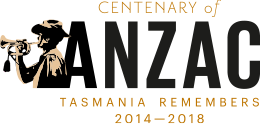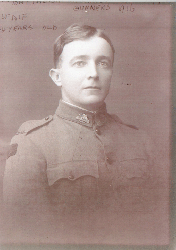Thomas Alexander Goyne OBE
The Federal President of the Military Historical Society of Australia, Rohan Goyne, researched the war service of his grandfather, Thomas Alexander Goyne OBE.
Thomas Alexander Goyne was a miner from Lottah, Goulds Country in Tasmania, who saw active service in both World War One and World War Two.
He enlisted on 13 October 1916 and served with the 12th Battalion from February 1917 to February 1918. On 4 August 1917 Private Goyne left Australia aboard HMAT Themistocles A32.
The Federal President of the Military Historical Society of Australia’s, Rohan Goyne, said his grandfather was one of the 495 Tasmanians who volunteered to fight in the Great War with the 2nd Company, 1st Machine Gun Battalion which was part of the 1st Division.
Going into battle
Private Goyne saw action with the 1st Machine Gun Battalion in the Allied Advanced to Victory battles on the Western Front during 1918. The Allied Advanced to Victory battles allowed more freedom of movement on the Western Front from Hamel to Montbrehain, in France. He was ‘taken on strength’ on 20 April 1918 and was posted to the 2nd Company, 1st Machine Gun Battalion. During May and June 1918, the 1st Division kept up a relentless campaign of local tactical advances referred to as “peaceful penetration”.
The 1st Division participated in the:
- Battle of Mont de Merris during 28 – 29 July 1918.
- Battle of at Lihons Heights on 9 – 11 August 1918 in which the Germans failed to expel the Australians. However, the 1st Division’s 2nd and 3rd brigades suffered nearly 1,600 casualties over just two days.
- Battle for Chuignes on 23 August 1918. The operation was a success but claimed about 1 000 casualties.
- Two-stage assault on the outpost of the Hindenburg Line on 18 September 1918
- Battle of Montrehain on 5 October 1918, which was the last action involving Australian infantry on the Western Front in the First World War. After breaking the Hindenburg Line, the attack on Montbrehain on 5 October 1918 represented an attempt to breach the final elaborate system of German defences based on the Beaurevoir trench line system.
Future service
Thomas Goyne returned to Australia on the Takada on 2 September 1919 and was discharged from the Australian Imperial Force on 10 October 1919. He went on to serve in the interwar years with the regular army, receiving a commission in 1938 and going to the Middle East with the Silent Seventh Division.
His son, Alan, who was born in Hobart, enlisted in World War Two as a navigator with the RAAF as part of the Empire Air Training Scheme. He was killed in a training accident in Victoria in 1942.
Thomas Goyne retired in 1950 having achieved the rank of Lieutenant Colonel. In the same year he received an Order of the British Empire (OBE) for his service to the military. He eventually left Tasmania to live in Victoria and died in 1966.
His grandson, Rohan, was born the following year. Despite having never met his grandfather, Rohan has researched his grandfather’s war service, travelled to the battlefields of the Western Front, and consequently become very interested in military history ultimately joining the Military Historical Society of Australia. Through his interest in family and military history, Rohan is helping to ensure the memory of Thomas Goyne and those who served live on.
Rohan Goyne is currently the Federal President, Military Historical Society of Australia.
References
Historical Notes Thomas Alexander Goyne 7689 Second Machine-Gun Company 1st Machine Gun Battalion France 1918 by Rohan Goyne (grandson of Thomas Goyne)
Australian War Memorial
http://www.awm.gov.au/people/rolls/R1824221/
Thomas Alexander Goyne’s War Service Records, National Archives of Australia
http://recordsearch.naa.gov.au/SearchNRetrieve/Interface/DetailsReports/ItemDetail.aspx?Barcode=4668775&isAv=N
https://www.awm.gov.au/units/event_135.asp


